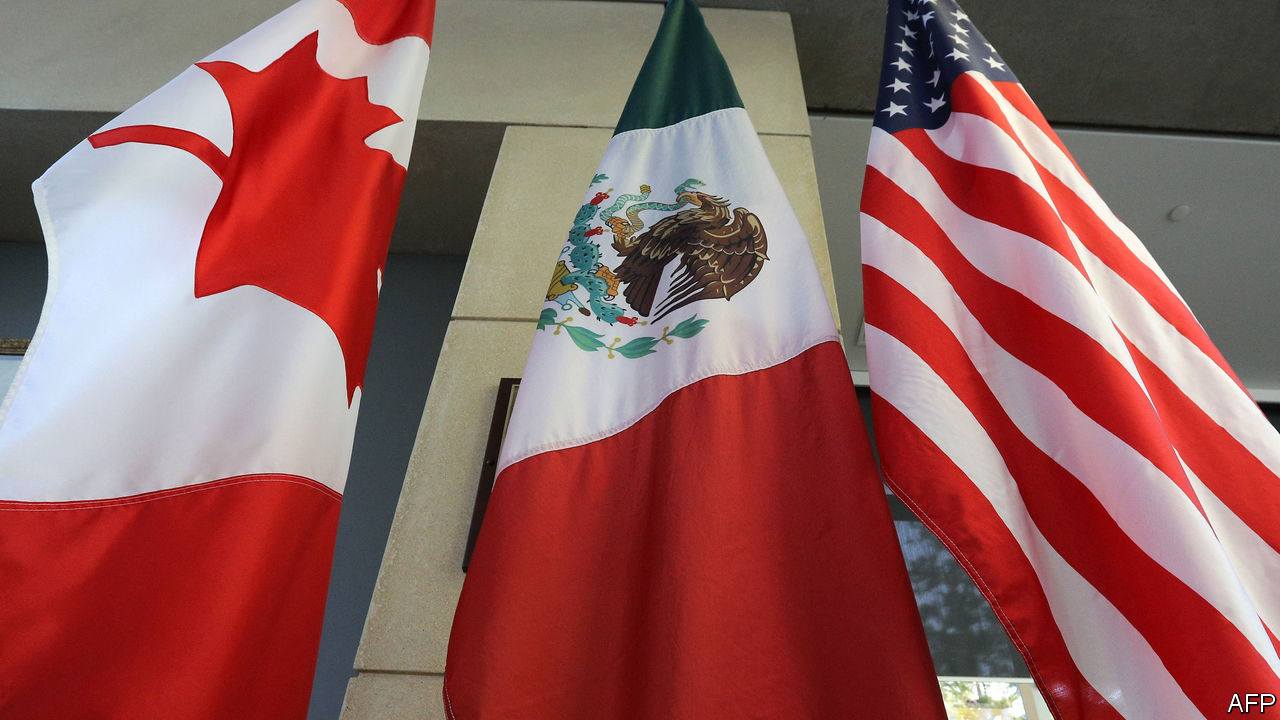
PRESIDENT DONALD TRUMP is fighting trade battles on multiple fronts. But on September 30th he called a truce in one of them. Having threatened to rip up the North American Free Trade Agreement (NAFTA), a trade deal between America, Canada and Mexico, he has agreed instead to replace it. With the Canadians now on board, and with the text of the agreement submitted to America’s Congress, leaders from the three countries will sign the new pact by the end of November. It will be relabelled the USMCA (United States, Mexico and Canada Agreement). So in one sense, at least, America will be first.
Striking the deal meant resolving disagreements between American and Canadian negotiators (those between Americans and Mexicans were resolved a month ago). The Americans had wanted to get rid of “Chapter 19”, a way of settling disputes about defensive tariffs, to prise open the Canadian dairy market to American farmers and to increase the “de minimis threshold”—the price below which small items can enter Canada duty-free. The Canadians wanted to keep Chapter 19, and to receive assurances that they would not be thwacked by tariffs on cars or car parts.
The eventual compromise involved handing the Americans some extra market access in dairy, as well as a higher de minimis threshold. Chapter 19 survived, and the Canadians received assurances of some protection from tariffs on cars and car parts. The Trump administration’s tariffs on imports of Canadian steel and aluminium are still in place, although on October 1st the president spoke of talks to remove them.
These last-gasp changes do not necessarily represent the most important alterations to the original deal. The biggest innovation in the USMCA is probably its rules of origin for vehicles. The new deal will raise the regional-content requirements a car must meet in order to be allowed to move tariff-free between the three countries, tilting carmakers towards using North American inputs. (Canadian parts-makers seem pretty pleased with the result.)
The full impact of the new deals will not be clear immediately. The USMCA contains hundreds of pages of legalese. Companies will need time to work out how to comply with the new rules. As experts trawl through the text published late on September 30th, they will no doubt discover clauses that were not widely trailed. It included, for example, a new clause containing fiery language about the consequences of one of the parties starting trade negotiations with a “non-market country” (probably code for China). If such a deal contained something the other partners did not like, the clause threatens that the trilateral pact could yet become a bilateral one.
Whatever details emerge, the USMCA is unlikely to be worse than no deal at all. It should provide some certainty for the people and businesses worried about NAFTA’s demise, and avert the protracted political battle that would have resulted had the Trump administration tried to push through a bilateral deal with Mexico alone.
But all is not necessarily plain sailing. To come into effect, the USMCA must be ratified by each country’s congress. And awkwardly, the Trump administration has run out of time for the current American Congress to consider it. Mr Trump seems very pleased with his new trade deal. But if the Republicans lose seats in the mid-term elections, a Democrat-controlled House of Representatives may not be inclined to cement his legacy.








